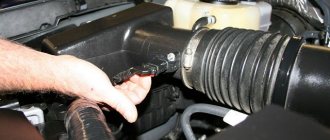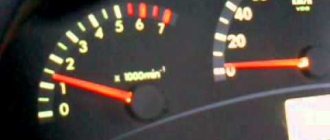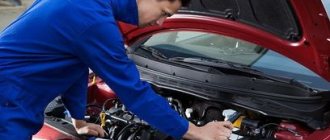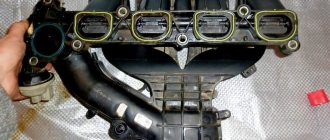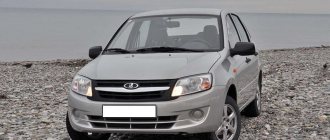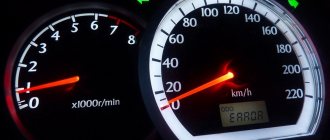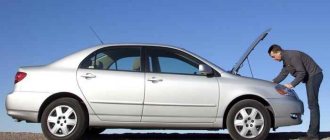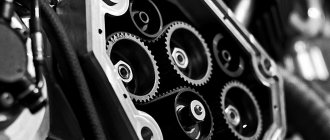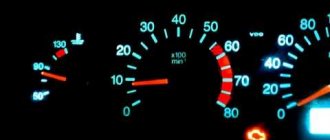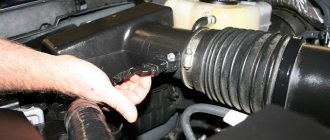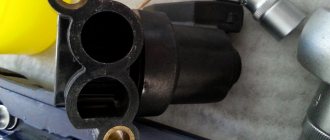What is the consumption of gasoline and diesel for idle speed
at one o'clock? List of reasons
Drivers are often interested in the consumption of gasoline and diesel at idle speed per hour. After all, it is often necessary to keep a running car in this particular mode. In winter, this is a warm-up before the trip. Also be aware of stops at traffic lights and in traffic jams. The entire range makes you think about how economical a car engine is when idling. At the same time, this question is asked by owners of all car models, regardless of the fuel consumption declared by the manufacturer. Knowing the average consumption will allow you to accurately calculate the amount of fuel when refueling.
What is the consumption of gasoline and diesel at idle speed per hour?
, depends on several reasons.
It is important to take into account the type of fuel
, the features of a particular engine, and the serviceability of all parts of the unit. Only taking into account all these aspects can approximately calculate fuel consumption.
Fuel consumption at idle per hour and what affects it
Gasoline consumption by the engine begins to worry car owners most often in winter, because it is with the advent of frost that the amount of money given at gas stations increases. Wanting to optimize their budget, drivers begin to search for the causes of the situation and are certainly faced with the question of fuel consumption by the engine at idle per hour.
Next, we will talk about the factors influencing the amount of gasoline burned by the engine, and about ways to independently measure the energy consumption of the power unit while the car is parked. Readers will also be given tips on optimizing fuel consumption.
Video... Opinion of car owners
In total, all the cases and situations described above lead to the fact that motorists who keep track of fuel consumption and try to save in every possible way are missing several liters of gasoline or diesel. On the other hand, if an additional load is placed on the engine in the form of an air conditioner, then the owners of large rather than small cars will benefit; the amount of energy required is directly proportional to the concentration of the air-fuel mixture, and it is much easier for an engine with a large volume to rotate the compressor at idle speed.
Is long-term idling dangerous?
To maintain stable idling, the engines are equipped with various special sensors that allow the power unit to increase speed if the engine is not warmed up or if its operation is unstable. We will take the standard case of 10 minutes before work, and 10 after work, why 10, because rarely will anyone change the standard alarm settings for 5 minutes or less.
About the alarm
Alarm system with auto start, allows you to start the car for 5 - 10 minutes. Moreover, usually the default is 10 minutes, but you can set it to 5, on some alarms it’s 3 minutes.
You can set it to run automatically by time, for example:
- Will start before you arrive
- Or by time interval (every 2 hours),
- By temperature (warmed up - stopped - cooled down - started again).
- Well, of course, you can start it yourself from the window in the morning (this is if the car is parked in front of the windows).
The most common are points 1 and 4, and basically no one removes the factory settings; the machine “keeps on” for 10 minutes. (it is during this time that we will calculate fuel consumption below)
How to save on fuel in winter and other periods of the year • I recommend reading
| Fuel consumption at idle and how much gasoline is spent at idle. Therefore, you should follow the rule: if you are going to stop for more than 30 seconds, turn off the engine, except, of course, when driving around the city, when you have to constantly stop due to traffic jams and traffic lights. This will prevent troubles that may arise in the spring when groundwater is high; tanks emptied during the winter may float. |
| Fuel consumption at idle speed can be calculated. To warm up all the components, as well as the heating system, at once, experts recommend letting the engine idle for 30 seconds to 3 minutes, and you can drive off at low speed even in the coldest winter time. Wanting to optimize their budget, drivers begin to search for the causes of the situation and are certainly faced with the question of fuel consumption by the engine at idle per hour. |
- Clutch problems. Complete replacement, as in 95% of cases it cannot be repaired.
- Problems with ignition of the working mixture. In case of such problems, it is better to go to a car service center, where, using special instruments, they will set new, now correct, ignition angles. This will avoid high fuel consumption in the future.
- Spark plug gap. You can solve the problem yourself. This requires special feeler gauges and knowledge of the correct clearances for your engine. After this, high fuel consumption will be reduced.
- Insufficient antifreeze temperature. There may be several reasons, often this is depressurization of the system. To fix the problem, perform a full diagnostic.
- Low compression level. This requires replacement of some components of the CPG (rings, pins, pistons, etc.).
- Crank system. Replacing bearings.
- Timing. At the service station they will diagnose and replace everything necessary. This will reduce high fuel consumption.
- Wheel alignment. A service station with special equipment will set the correct wheel angle.
- Tires. Just make sure they have normal pressure.
- Air filter. Diagnostics and replacement of some components of this system should be carried out every 5-7 thousand kilometers.
- Thermostat. Replacing or cleaning can reduce high fuel consumption.
- Electronic system. Over the past 10-15 years, almost all cars have adjusted the working mixture using electrical devices. But few people know that they may start to work incorrectly. If this is your case, have your car checked by professional electricians.
- Problems with the injector. The main reason for high fuel consumption on the injector is its malfunction. A qualified specialist will be able to fix everything and return acceptable costs.
Example of idle flow calculation • Important At lower temperatures, the figure changes because the engine takes longer to warm up.
So is it necessary to turn off the engine when idle?
So, the easiest way to save fuel is to turn off the engine while it is running. If you think that we are talking about some drops, then you are mistaken. It is not without reason that many modern cars are now equipped with a system called “start-stop”, which turns off part or all of the cylinders while the car waits in traffic jams or at city traffic lights. However, not everyone’s car can boast of such a technical innovation. And then the car enthusiast notes with surprise how the consumption of his car has increased and asks himself the question why this happened...
That is why experienced drivers who want to save on maintenance turn off the engine in all cases if they have to stand idle for more than 10 seconds. This is such an average value at which it is advisable to wonder whether the fuel is simply flying out of the gas tank into the pipe?! This is especially true in cases where the vehicle has stopped in a safe place, without creating any interference with other traffic participants or emergency situations.
How much does autostart consume • Ignition system
| What is the fuel consumption at idle - Autolife In such a case, the volume of fuel consumed during the test will need to be multiplied by 3; this coefficient is found using the formula K 60 X, where X is the time of the experiment in minutes. At least some drivers, whose cars idle the most, will turn off their car engines, receiving signals from the control system and explanations from their fleet managers. |
- warm up the engine for no more than 5 minutes - until the “warm-up” speed drops;
- do not turn on the headlights when warming up, reduce the intensity of the interior heating system to a minimum;
- use heated windows and mirrors only when absolutely necessary;
- insulate the engine and install an autonomous heating system - as a result, the likelihood of engine freezing will be reduced to a minimum.
Like overall fuel consumption, which I already discussed in this article, fuel consumption at idle is influenced by many factors, including:
- The serviceability of the engine, as well as all systems that relate to fuel consumption (stove, air conditioning, etc.);
- Engine capacity;
- Ambient temperature;
- Number of included energy consumers (“air conditioner”, stove, headlights, radio, etc.);
- Fuel quality. If, for example, you fill in 92 instead of 95, then be prepared for the consumption to increase. In addition, if the fuel is of low quality, then its consumption will be higher by about 15-20%, depending on the “degree of lousiness”.
To begin with, I will say that if we talk about approximate figures, then fuel consumption at idle speed per hour is equal to the car’s consumption per 100 km divided by 10. That is, if your consumption is 7 liters. per 100 km, then divide 7 liters. by 10 and we get 0.7 liters.
How much fuel does an idling engine consume: technical aspect
Running the engine at idle speed and stopping it and starting it again are two completely different conditions in terms of fuel efficiency. The information below will help you understand how much fuel is consumed when the engine is idling.
Depending on engine type
The fact that an idling engine consumes fuel is a well-known fact, but the question is different - how much exactly? Research results have shown that the amount of fuel consumed depends on the specific vehicle and the type of engine it is equipped with. But, on average, the consumption is 0.55-0.75 l/h.
Compact models with a 2-liter engine consume about 0.6-1.15 liters of fuel per hour. When it comes to large sedans with a 4.6-liter engine idling, this figure increases to 1.9-2.6 l/h. If we talk about diesel engines, then when idling they consume a small amount of fuel. And the whole point is the absence of any restrictions regarding the throttle valve.
Turning off and restarting the engine
Many people believe that restarting the engine after turning it off uses more fuel. But it is not so. Idling the engine for just 10 seconds requires more fuel than starting it again.
The less the engine idles, the less fuel consumption and the less money spent. When starting the engine, there is less load on it than when it is idling.
How to drive correctly to get rid of increased fuel consumption
Meanwhile, according to American researchers, in one hour of idling every day for a year, the engine of a heavy truck receives the same wear as a trip over 100,000 km. Thus, if every driver clearly knows and follows when to leave the car’s engine idling, and when to turn off the engine, you can save a lot of money on fuel costs.
Share. I recommend reading
| Question for diesel drivers: we kill the engine by warming it up at idle - Other Toyota-related questions. Excessive fuel consumption occurs during sudden acceleration and braking, and therefore if you like to start with what is called slipping or often perform the acceleration and braking procedure, then be prepared for excessive fuel consumption. For modern liquid fuel heating units with imported burners, it is necessary to purchase high-quality fuel, which must correspond to the season of use. |
- warm up the engine for no more than 5 minutes - until the “warm-up” speed drops;
- do not turn on the headlights when warming up, reduce the intensity of the interior heating system to a minimum;
- use heated windows and mirrors only when absolutely necessary;
- insulate the engine and install an autonomous heating system - as a result, the likelihood of engine freezing will be reduced to a minimum.
Engine operation at full load. • And if in first gear and the gas is to the floor, you get all 50 liters per hour, or, even more fun, 150 liters per 100 km.
Laboratory work Effective performance of diesel engines
The purpose of the work is to experimentally determine the main effective indicators of a diesel engine at various load modes of its operation.
Necessary theoretical information
There are effective and indicator indicators of internal combustion engines. The name itself – “effective” – emphasizes that these indicators characterize those qualities of the engine that go to the consumer, i.e. create the beneficial effect for which the engine was created. Indicator indicators characterize the process occurring in the engine cylinders. So, for example, indicator work is the work that is performed by gases in the cylinders, and effective work is that which is removed from the engine crankshaft for the needs of the consumer. Due to the presence of mechanical resistance in the engine itself, the effective work (power, average pressure, efficiency) will be less than the indicator work (power, average pressure, efficiency). For the same reason, the specific effective fuel consumption will be greater than the indicator one.
Let's look at the above indicators in more detail. Effective power is the useful power of the engine,
transmitted from the engine crankshaft to the consumer.
When testing an engine, different methods of creating a load are used, so power calculations can be performed using different formulas. When using hydraulic and electromagnetic load devices, the braking torque is directly measured, which is equal to its torque (effective torque) Mcr in steady state mode of the engine. The relationship between the effective torque Mcr, N. m and effective power Ne, kW is set by the equation
Fuel consumption at idle: and how to reduce it?
Good afternoon, dear car enthusiasts! I am glad to talk again about automotive topics with everyone who is not indifferent to it. Those who read us in previous issues know very well that we paid great attention to issues related to vehicle fuel consumption. In this review, I wanted to touch on fuel consumption at idle, how to find it out and what affects it.
So, the easiest way to save fuel is to turn off the engine while it is running. If you think that we are talking about some drops, then you are mistaken. It is not without reason that many modern cars are now equipped with a system called “start-stop”, which turns off part or all of the cylinders while the car waits in traffic jams or at city traffic lights. However, not everyone’s car can boast of such a technical innovation. And then the car enthusiast notes with surprise how the consumption of his car has increased and asks himself the question why this happened...
That is why experienced drivers who want to save on maintenance turn off the engine in all cases if they have to stand idle for more than 10 seconds. This is such an average value at which it is advisable to wonder whether the fuel is simply flying out of the gas tank into the pipe?! This is especially true in cases where the vehicle has stopped in a safe place, without creating any interference with other traffic participants or emergency situations.
How to prevent high fuel consumption on a diesel engine? I recommend reading
| Duster consumption at idle - Gasoline consumption at idle If the car is often idle in traffic jams, its engine is on, the air conditioner and other attachments are running, then in such a case an oil change will be required at 5,000 kilometers, and not at 8-10 thousand kilometers, as when operating a car in city conditions or on country roads. In this mode, quite a lot of fuel can be consumed, even a relatively small diesel engine burns more than 1 liter of fuel per hour and emits about 1.5 kg of CO2 into the air, and a large engine, and even if the air conditioning is turned on in the car, can consume up to 4 liters at idle h or more. |
- Coasting reduces consumption
. This is only partly true. Indeed, with a sharp release of gas at a specific point in time, the fuel supply is reduced. This is done to stabilize engine operation. But, with constant idling, fuel consumption is not much less. At the same time, do not forget that in the future you will need to pick up speed, which decreases when coasting, this leads to an increase in fuel consumption. Accordingly, all savings are eliminated. The only option for using coasting is to pre-reduce speed when stopping or before turning; - In traffic jams you need to turn off the engine
. Supposedly this saves fuel. This myth appeared simultaneously with the start-stop function in modern cars. Manufacturers needed to sell this new product to drivers. In fact, it makes sense to turn off the car when parked for more than 10 minutes. If you turn off the engine every time you stop, the consumption will only increase. When starting the engine, some of the fuel simply flies out into the exhaust pipe without any effect. This also increases the wear rate of power unit parts. Therefore, do not turn off the car when stopping at a traffic light; - Installing a spoiler reduces consumption
. This statement is true exactly the opposite. In fact, the wing is designed to press the car to the road. This happens due to an increase in resistance to oncoming flow. Accordingly, the higher the angle of attack and downforce, the more fuel consumption increases. This myth comes from motorsport, where a wing really reduces fuel consumption, but there the spoiler or wing is selected individually, and the car is necessarily blown in a wind tunnel; - The higher the gear, the lower the consumption
. In fact, this is not entirely true. The optimal engine operating mode from the point of view of economy is 70-75% of maximum speed. For example, at a maximum speed of 4000, the most economical will be to maintain 3000-3100 rpm. In a high gear, the engine runs at lower speeds and consumption increases.
The most common reasons for excessive consumption of diesel fuel: description
The main reasons for increased fuel consumption on diesel engines and the simultaneous appearance of increased smoky exhaust include:
- The appearance of insufficient tightness of the power supply system.
The tightness of the power supply system for a diesel engine is of particular importance. In particular, air leaks in the inlet part of the system (from the fuel tank to the fuel priming pump) leads to malfunction of the fuel supply equipment. And the broken seal of the part of the system that is under pressure (from the fuel priming pump to the injectors) causes leakage and significant excess fuel consumption. A leak in the power system often occurs due to a violation of the tightness of the connections, due to natural wear or mechanical damage. Violations in the tightness of high-pressure fuel pipe connections are determined by a small output of diesel fuel at the places where the tubes are attached to the pump fittings and injectors when the engine is running.
- Clogged air and/or fuel filters.
This is a very common reason for increased fuel consumption on a diesel engine, which perhaps should even be placed first on the list of the main reasons for excessive consumption. Filters become clogged more quickly with regular use of equipment on dirt or gravel roads and off-road; when periodically using diesel fuel of questionable quality, with foreign impurities. However, the polluted air of especially busy roads in the cramped state of modern megacities also has a detrimental effect on the condition of air filters.
The most common reasons for excessive consumption of diesel fuel: description
- Clogged fuel drain line.
If the fuel drain line (from the pump to the fuel tank) is clogged or deformed, this will also negatively affect diesel fuel consumption.
- Contamination or wear of injectors.
This is a more serious problem that requires repair or replacement of the injectors with new ones. When using low-quality fuel, these rather demanding devices become clogged very quickly, which leads to their damage in the future.
- Violation of the fuel injection advance angle depending on the rotation speed.
The amount of working fluid in the combustion chamber of the engine and its temperature depend on the rotational speed of the crankshaft - the speed of movement of the piston in the engine cylinder. As the crankshaft rotation speed increases, the absolute durations of ignition delays (in milliseconds) are reduced, but the relative durations in degrees of crankshaft rotation increase. We must not forget about such a moment as injection delay (the time between the start of fuel supply by the pump and the injection of fuel by the nozzle into the combustion chamber). The higher the crankshaft speed, the earlier fuel needs to be injected into the combustion chamber, and vice versa.
- Large gaps in the valve mechanism.
Correct clearances in the valve group are a necessary element that ensures the correct operation of the entire gas distribution mechanism of the engine as a whole. The size of thermal gaps can be 0.08...0.45 mm, and is standardized for each engine by its manufacturer. After the diesel engine has warmed up, all its operating parts are, to one degree or another, subject to thermal expansion, which depends both on the degree of heating and on the size of the parts, and on the coefficient of thermal expansion of the metal from which these parts are made. Most engine parts expand quite strongly, as they have a fairly serious coefficient of linear deformation of the metal from which they are made.
- Severe wear of the crank mechanism, due to which the engine power decreases.
